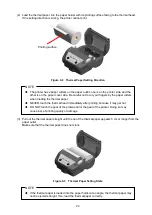
9
Precautions for Wireless communication
◆
When using the Bluetooth interface, the communication may become unstable due to the influence
from external radio waves. This is based on Bluetooth specification which is a wireless
communication standard.
◆
The Bluetooth model operates in the 2.4 GHz frequency range. The Wireless LAN model using
IEEE802.11b/g/n operates in the 2.4 GHz frequency range, and IEEE802.11a/n operates in the 5
GHz frequency range. So if these models are used around other wireless LAN or any equipment
using the same frequency range such as a microwave oven, radio frequency interference may
occur, and the communication may become unstable. When it happens, turn off the interfering
equipment or increase the distance. Alternatively, shorten the distance between the host device
and the printer as much as possible.
◆
When operating the Wireless LAN model using IEEE 802.11a/n, the printer may stop
communication temporarily before outputting radio wave to the target channel not to affect the
weather radar, air traffic control radar or others. This is to monitor the presence of radar waves for a
certain time. If the printer detects radio waves such as radar during operation, it may switch to
another channel.
Precautions for maintenance
◆
Clean the products' cases using a soft and lint-free cloth. DO NOT use alcohol or other solvent.
◆
Before using, clean the terminals using a dry, soft, and lint-free cloth when they are dirty. If the
terminals are dirty, it may cause contact failure.
◆
When cleaning the thermal head, always wipe it with a cotton swab or other soft material.
Precautions for storing
◆
Turn off the printer when not in use.
In addition, when the printer is not used for a long time,
•
Remove the battery pack from the printer. If not, it will cause overdischarge, and the battery
pack will not be usable even after it is charged.
•
Unplug the AC plug from the outlet.
•
Set thermal paper to protect the platen.
◆
When the printer is not used for a long time, store the battery pack in a cool place. Avoid long-term
storage in a fully charged state as much as possible because it may shorten the life span of the
battery pack.
Thermal Paper Handling
◆
Store the thermal paper in a cool, dry, and dark place.
◆
DO NOT rub the thermal paper with hard objects.
◆
DO NOT leave the thermal paper near organic solvents.
◆
DO NOT allow PVC film, erasers, or adhesive tape to touch the thermal paper for long periods.
◆
DO NOT stack the thermal paper with diazo copies immediately after copying.
◆
DO NOT use chemical glue.














































